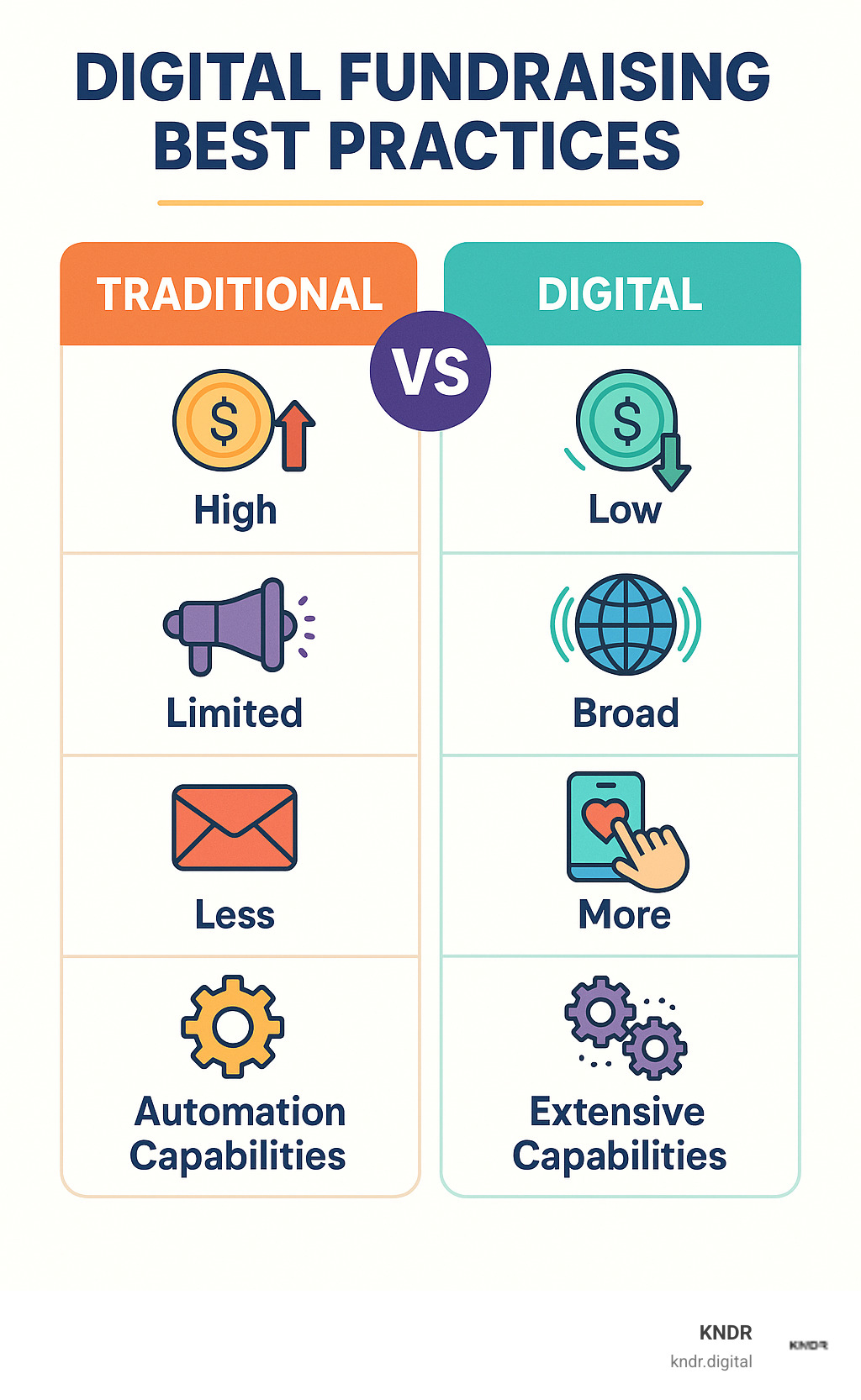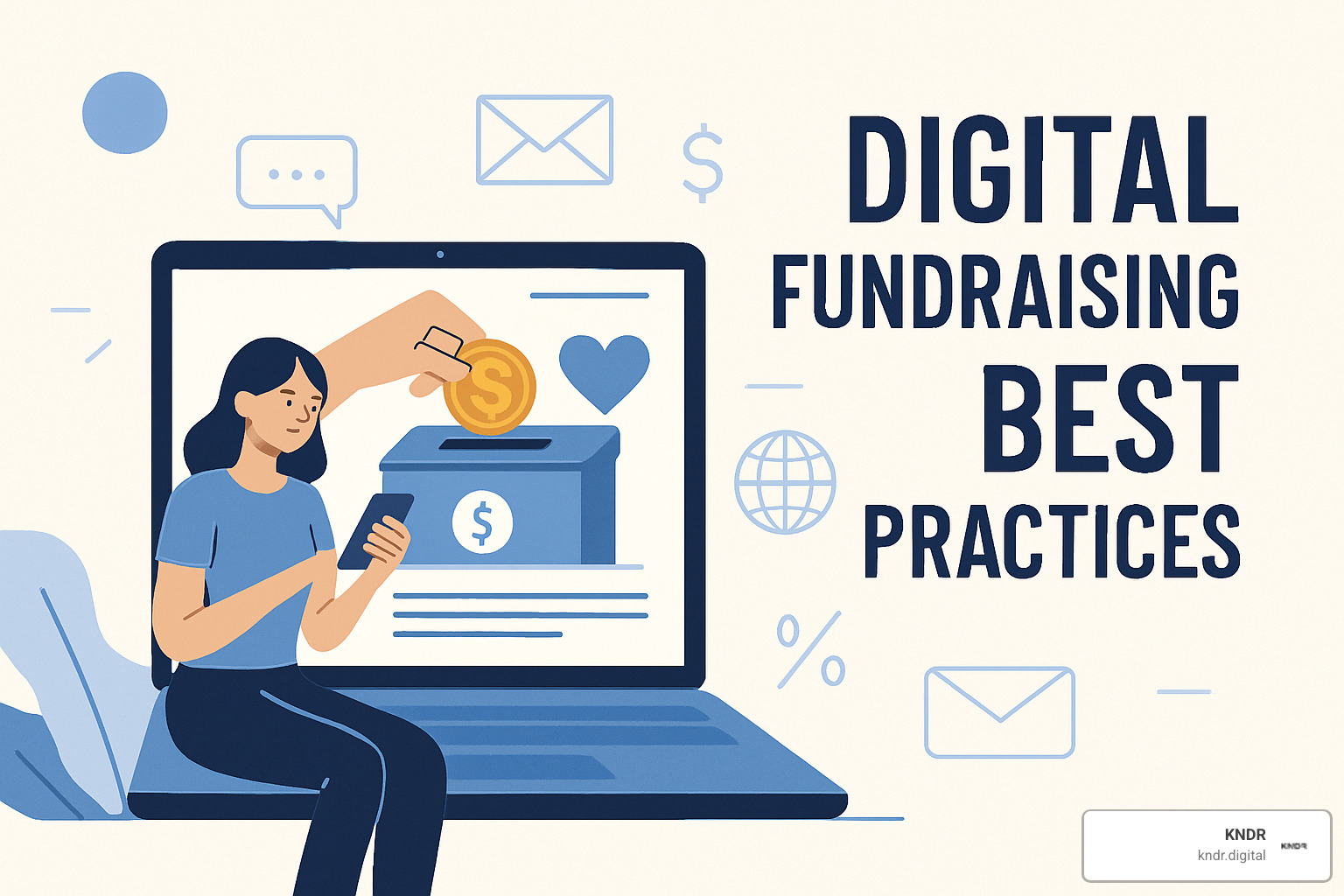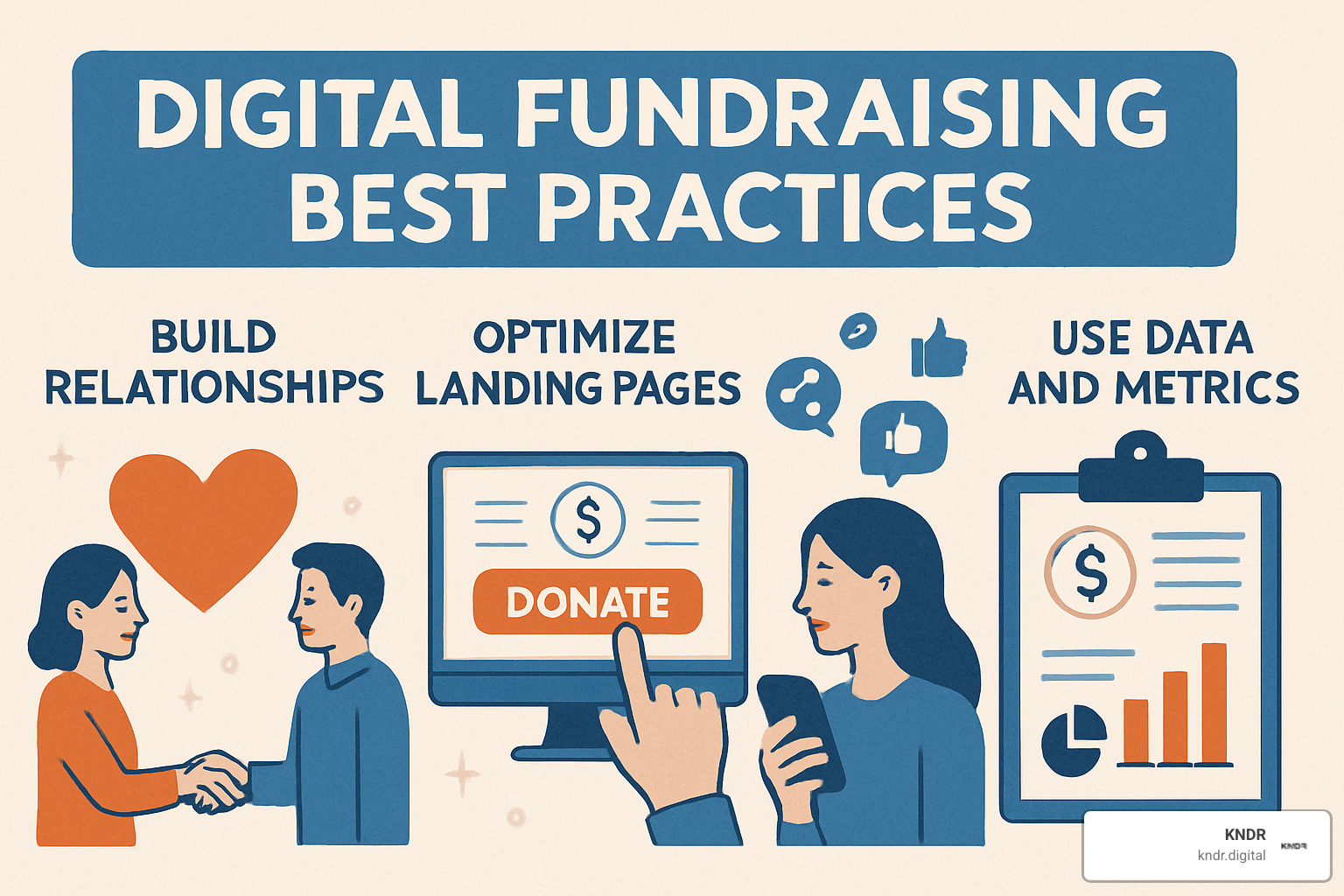Crowdfunding and Beyond: Digital Fundraising Best Practices for Nonprofits

Why Digital Fundraising Best Practices Are Essential for Modern Nonprofits
Digital fundraising best practices are proven strategies that help nonprofits raise more money online while reducing costs and workload. Here are the core practices every nonprofit should implement:
Essential Digital Fundraising Best Practices:- Mobile-first donation pages with minimal fields and multiple payment options- Monthly giving programs to create predictable revenue streams- Email segmentation to send personalized appeals based on donor behavior- Social media campaigns on Facebook, Instagram, and TikTok for broader reach- Peer-to-peer fundraising to leverage supporter networks- Text-to-give campaigns for immediate, on-the-go donations- AI-powered donor insights to optimize ask amounts and timing- Thank-you automation to improve donor retention rates
73% of nonprofit donors prefer to give online via card or PayPal, yet many organizations still rely heavily on expensive traditional methods. In-person fundraising events can cost up to 75 cents of every dollar raised, while digital campaigns offer 24/7 donation capabilities at a fraction of the cost.
Online giving now accounts for 12% of total nonprofit revenue, and 57% of nonprofit website traffic comes from mobile devices. Organizations that accept digital-first strategies see higher donor retention rates and can reach global audiences without geographic limitations.
I'm Mahir Iskender, CEO of KNDR.digital, where I help mission-driven organizations scale through AI-powered marketing and performance-based growth strategies. My team has implemented digital fundraising best practices for nonprofits ranging from local charities to international organizations, consistently driving measurable increases in donor acquisition and retention.

From Mailers to Mobile: What Is Digital Fundraising?
Digital fundraising has completely transformed how nonprofits connect with supporters, moving from costly printed appeals to smart online strategies that work around the clock. The first "Donate Now" button appeared in 1999, but COVID-19 accelerated adoption when organizations had no choice but to go digital overnight.
Digital fundraising uses websites, social media, email, and mobile apps to create donation opportunities that never sleep. Unlike traditional methods requiring months of planning and hefty upfront costs, digital campaigns can launch quickly and adapt based on real-time results.
The numbers are compelling: The cost of an in-person fundraising event can be up to 75 cents of every dollar raised, while digital campaigns typically cost just 10-20 cents per dollar raised.
Digital fundraising best practices focus on using data to understand donor motivations, then creating personalized experiences that make giving simple and meaningful. Instead of generic letters, you can segment supporters based on interests and giving history, crafting targeted messages that resonate.
Key Differences at a Glance
| Method | Cost Per Dollar | Reach | Setup Time | Personalization | Real-time Data |
|---|---|---|---|---|---|
| In-Person Events | $0.50-$0.75 | Local/Regional | 3-6 months | Limited | None |
| Direct Mail | $0.25-$0.50 | Geographic | 4-8 weeks | Basic | Delayed |
| Digital Campaigns | $0.10-$0.20 | Global | 1-2 weeks | Advanced | Instant |
Why It Matters: Benefits for Nonprofits & Donors
Digital fundraising transforms nonprofit operations through global reach, lower costs, and mobile convenience. A small shelter can now receive donations worldwide, while costs drop from 50-75 cents per dollar to just 10-20 cents.
With 28% of online donations happening on smartphones, donors love giving while waiting for coffee or riding the bus. Matching gifts become easier to manage digitally - since 65% of Fortune 500 companies offer matching programs, automated tools can potentially double donations.
Transparency builds trust through real-time updates, impact photos, and instant financial reports. Donors see exactly how their $50 helped feed 20 families, strengthening relationships and encouraging repeat giving.
Data-Backed Impact
Data-Driven Fundraising shows organizations using well-designed online fundraising forms raise 25% more than basic setups. Segmentation transforms generic appeals into personal conversations, while AI-powered personalization suggests optimal ask amounts based on donor patterns.
Nonprofits using these strategies see higher conversion rates, larger average gifts, and better donor retention - building stronger, longer-lasting relationships with supporters.

10 Digital Fundraising Best Practices You Can Implement Today
These digital fundraising best practices are battle-tested strategies that deliver real results. You can see what's working almost instantly - launch Monday, check data Tuesday, improve by Wednesday.
After helping hundreds of nonprofits boost online giving, we've identified strategies that consistently move the needle. Some see results within days, others take weeks, but every nonprofit committed to these practices sees measurable improvement.
Start with fundamentals and build from there. Pick practices aligning with your current capacity, then expand as you gain confidence. Our Digital Fundraising Strategies guide covers each practice in detail.
1. Build Friction-Free Donation Pages
Your donation page bridges generous impulses and actual gifts - unfortunately, where many good intentions get lost. One in six donors abandon their journey when redirected to third-party payment sites, making hosted forms on your domain essential.
Mobile-first design is critical with 57% of nonprofit traffic from mobile devices. Design for thumbs: large buttons, minimal fields, fast loading. Keep forms simple - name, email, payment details. That's it.
Payment flexibility matters. Offer credit cards, PayPal, Apple Pay, Google Pay, and ACH transfers. Bonus: 50% of donors will cover processing fees if given the option.
The recurring gift toggle might be your most powerful element. Monthly donors average $79 monthly ($948 annually) versus typical one-time gifts. A simple "Make this monthly" checkbox transforms revenue.
Smart donation amounts using AI personalization suggest amounts based on donor history. When someone previously gave $75, suggesting $80-85 feels natural and often increases gift size.
For comprehensive optimization guidance, explore these donation page best practices.
2. Launch Mobile & Social Giving Campaigns
Meet donors where they are - scrolling Facebook during coffee, watching Instagram stories at lunch, finding causes on TikTok before bed.
Facebook remains the powerhouse with 56% of social-media-inspired donors crediting it as primary motivation. The platform has generated over $6 billion through built-in fundraising tools. Add donation buttons to posts, create supporter fundraisers, collect donations during Facebook Live.
Instagram lets donors give without leaving the app, removing friction. TikTok opens doors to younger donors - 60% are Gen Z spending 95 minutes daily on platform. Create authentic behind-the-scenes content and trending challenges adapted for your cause.
Text-to-give campaigns offer ultimate convenience. Donors text a keyword, receive a mobile-optimized form link, and donate within 30 seconds.
Giving Tuesday demonstrates coordinated social campaign power - $3.1 billion raised in 2022. Smart organizations plan months ahead, creating countdown content building excitement.

3. Boost with Peer-to-Peer & Crowdfunding
Turning supporters into fundraisers taps into relationships in ways polished marketing can't match. 39% of Americans donate because friends or family asked, making personal connections your secret weapon.
Peer-to-peer fundraising works through personal networks. Supporters create branded fundraising pages, share with their circles. First-time peer-to-peer fundraisers raise average $222, returning campaigners average $501.
Provide success tools: templates, compelling images, suggested social posts. Make launching campaigns take minutes, not hours.
Crowdfunding rallies everyone around specific projects with clear goals and deadlines. "Help us build a playground by December 31st" creates urgency generic appeals lack.
Digital peer-to-peer campaigns generated $154 million across 44 organizations in 2021, up 30% year-over-year. Growth accelerates as people become comfortable with online giving and social sharing.
For proven expansion strategies, check our Digital Donor Acquisition guide.
4. Segment & Personalize with AI
AI acts as your tireless research assistant, analyzing hundreds of data points to find supporters most likely to give again, upgrade gifts, or become monthly donors.
Smart ask amounts represent AI's most practical application. Instead of generic $25, $50, $100 suggestions, AI personalizes based on donor history. When Sarah typically gives $75, suggesting $85 or monthly $30 feels natural and can increase average gifts by 15-25%.
Email personalization goes beyond first names. Advanced systems learn some donors respond to urgent Thursday morning appeals, others prefer detailed Sunday afternoon impact reports. AI tracks opens, clicks, and donations, optimizing future communications.
Predictive analytics spots trouble early. If John usually gives every three months but hasn't in four, the system flags him for gentle re-engagement, preventing donor loss.
Our The Complete Guide to AI-Powered Donor Segmentation shows implementation, even for non-tech-savvy users.
5. Prioritize Retention & Stewardship
Average nonprofits keep only 37% of donors year-over-year - 63 never give again. Organizations mastering digital stewardship see dramatically higher retention rates.
Thank-you automation should trigger immediately - within minutes, not days. Donors receiving immediate acknowledgment are 75% more likely to give again.
Personalized thank-you videos create emotional connections generic emails can't match. When your director says "Thank you, Sarah, for your $50 gift," it transforms transactions into relationships. Authenticity beats production value.
Show real-time impact instead of waiting for annual reports. "Your $100 provided clean water for 5 families this month" hits differently than generic annual summaries.
Monthly giving upgrades represent huge opportunities. Converting one-time donors to monthly supporters increases annual contributions 50-300%. Someone giving $50 once might give $25 monthly, resulting in $300 annually.
For comprehensive retention strategies, see Implementing AI for Donor Retention: The Complete Playbook.
6. Ensure Legal, Ethical & Privacy Compliance
Privacy regulations like GDPR and CCPA affect any organization accepting international donations or operating in privacy-law states. The biggest shift is consent management - clear, explicit consent for everything, not pre-checked boxes.
Your privacy policy needs plain English explaining how information is used, stored, and protected. If using AI for personalization, mention that too. Transparency builds trust.
Data minimization is both legal requirement and best practice. Only collect needed information for stated purposes. Cookie walls are prohibited in many jurisdictions - offer clear choices between essential and optional cookies.
Cryptocurrency donations require know-your-customer (KYC) protocols and careful tax reporting. The regulatory landscape evolves rapidly, so consult legal counsel.
Most compliance requirements align with donor expectations anyway - data protection, preference respect, and usage transparency.

Choosing Tools & Platforms for Sustainable Growth
Your ideal Charity Fundraising Platform should integrate donation processing, donor management, email marketing, and reporting seamlessly. When donors give, thank-you emails send automatically, records update, and reports reflect new data.
CRM integration is essential - real-time sync, not weekly uploads. Look for robust API capabilities handling complex nonprofit data relationships.
The best platforms automate thank-you sequences, recurring gifts, lapsed donor re-engagement, and upgrade campaigns while you focus on relationship building.
Evaluating Options & Integrations
Focus on total cost of ownership, not just monthly fees. "Free" platforms might cost more with transaction fees, setup costs, and integration expenses.
Scalability matters more than current needs. Choose platforms growing with your organization rather than forcing painful migrations. Analytics dashboards should provide actionable insights about conversion rates, donor lifetime value, and retention trends.
Future-Proof Innovations
Cryptocurrency acceptance moves from experimental to mainstream. Crypto donors make larger gifts and skew younger/wealthier. Contactless donations through QR codes work brilliantly for events and public spaces.
For detailed platform comparisons, see Best AI Tools for Nonprofits.
Measuring Success & Optimizing Campaigns
Counting donations feels good but won't tell you if fundraising actually works. Track conversion rates, donor lifetime value, and retention rates - metrics revealing whether you're building sustainable support.
Your conversion rate (percentage of visitors who donate) is your donation page report card. Great nonprofits see 3-5% or higher. Donor lifetime value changes spending decisions - when average donors give $500 over their relationship, spending $100 to acquire them makes sense.
A/B testing should become routine. Test one element weekly - subject lines, donation amounts, page layouts. Small improvements compound quickly.
Attribution modeling understands donor journeys. Someone might find you on Instagram, research on Google, donate through email. All channels deserve credit.
Our Fundraising Campaign Management guide shows exactly how to track and optimize these metrics.
Reporting & Continuous Improvement
Real-time dashboards help boards understand performance and justify marketing budgets. Benchmarking provides context - maybe your 25% email open rate beats the 20% nonprofit average.
Monthly performance reviews should feel like detective work. What made October better than September? Quarterly strategy sessions address bigger questions about audience, messaging, and tools.
Frequently Asked Questions about Digital Fundraising
What are the most important digital fundraising best practices for small nonprofits?
Start with basics delivering biggest impact. Your mobile-optimized donation page should be priority one - this single improvement can increase online giving by 25%+. Make it load quickly on phones, ask minimal information, offer multiple payment options.
Monthly giving options create predictable revenue. A simple "Make this monthly" toggle transforms $50 one-time donors into $600 annual supporters.
Email marketing generates $1.11 per contact for nonprofits. Focus on list building through website opt-ins and social campaigns. Basic segmentation dramatically improves engagement.
Social media fundraising through Facebook and Instagram costs nothing to start but expands reach exponentially through authentic storytelling.
How do we keep donor data secure while running online campaigns?
Choose PCI DSS compliant payment processing and SOC 2 certified data handling platforms. These certifications prove rigorous security standards.
Train your team on security - most breaches happen through suspicious links or weak passwords. Implement two-factor authentication and require strong, regularly updated passwords.
Regular security audits review data access, remove former staff from systems, and test backup procedures. Your privacy policy should explain in plain English what information you collect and how it's used.
Is cryptocurrency really worth accepting for donations?
Crypto donors tend to be younger, wealthier, and make larger gifts. However, crypto requires KYC protocols, specialized tax reporting, and governance policies. Administrative burden might outweigh benefits for smaller organizations unless you have tech-savvy donors.
Start simple with Bitcoin and Ethereum through established platforms handling compliance automatically. Test during specific campaigns to gauge interest without ongoing complexity commitment.
Conclusion
The journey to digital fundraising best practices represents more than technological shift - it's about meeting donors where they are and creating experiences that inspire continued giving. These strategies enable deeper personalization, more meaningful connections, and more transparent communication than traditional methods.
Organizations accepting mobile-first donation pages, AI-powered segmentation, and automated stewardship consistently outperform those stuck in old patterns. Beyond numbers, there's beauty in donors supporting your cause at 2 AM after reading inspiring social media stories, or monthly donors feeling genuinely connected through personalized impact updates.
At KNDR, our guarantee of 800+ donations in 45 days proves these practices work when implemented correctly. We've seen small local charities transform their reach and large organizations streamline previously manual processes.
Digital fundraising's beauty lies in accessibility. You don't need massive budgets or tech expert teams. Begin with friction-free donation pages, add email segmentation, gradually layer sophisticated tools as you grow. Each improvement builds momentum that compounds over time.
Donors increasingly expect seamless digital experiences, transparent communication, and personalized engagement. Organizations mastering these digital fundraising best practices today will find themselves with loyal, engaged donor communities growing naturally through word-of-mouth and social sharing.
Ready to see what's possible when technology serves your mission? Our comprehensive Charity Digital Change guide shows exactly how AI-powered strategies can amplify your impact while simplifying operations. The change starts with a single step, but results can transform how you connect with supporters and advance your cause.


